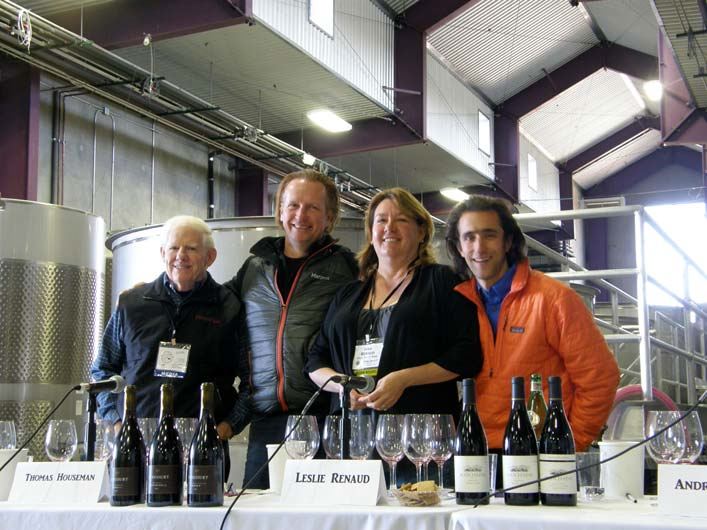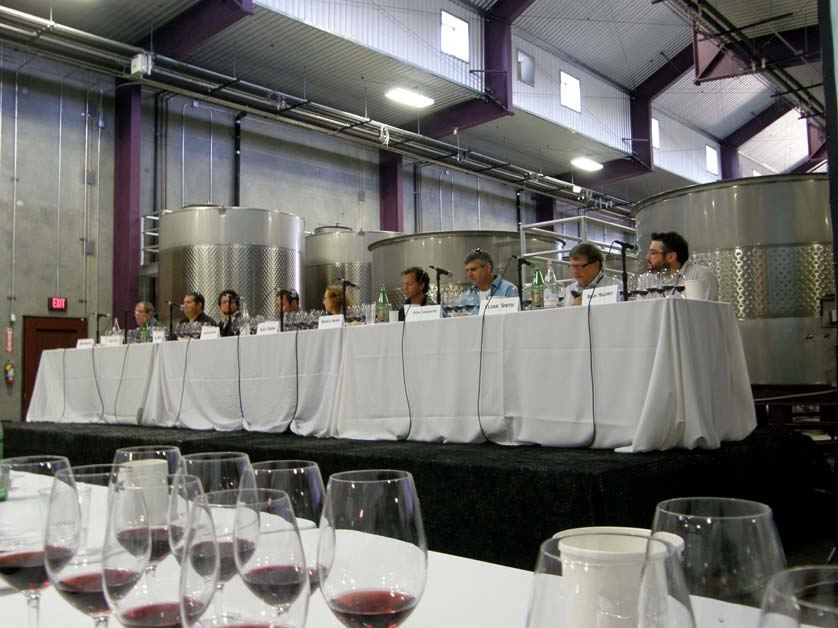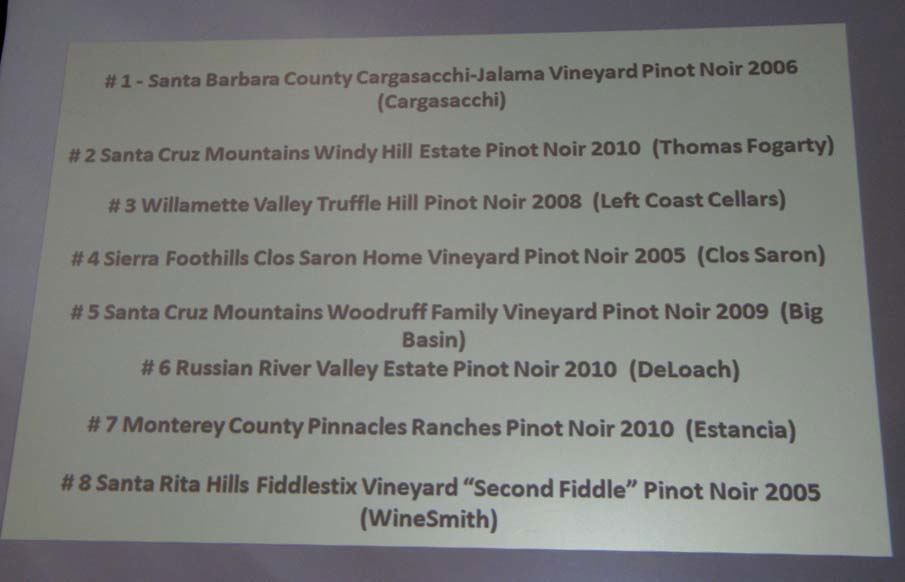12th Annual World of Pinot Noir
Each year on the first weekend in March a few thousand pinot geeks converge on the small beach side
community of Shell Beach at The Cliffs Resort to revel in the wines made from their favorite grape. This year’s
event was exceptional thanks to the efforts of Karen Steinwachs, the 2012 Chairperson, and the dedicated
work by the World of Pinot Noir Board of Directors and Advisory Committee. It was a weekend to renew old
friendships and make new friends, to discover new Pinot Noir producers as well as revisit established Pinot
Noir vintners, and to taste the current bounty of Pinot Noir from North America, New Zealand, Australia, Chile,
and Burgundy.
Two seminars were offered on Friday, March 2, hosted by winemaker Fintan Du Fresne and the crew at
Chamisal Vineyards in Edna Valley. The first seminar, titled “Technique v. Terroir: The Cube Project,” was
moderated by yours truly, and the second seminar, “Natural Winemaking,” was moderated by noted Pinot Noir
expert, John Haeger. I will summarize the discussion and conclusions reached at each seminar.
Technique v. Terroir: The Cube Project
Three winemakers, Thomas Houseman of Anne Amie Vineyards in Carlton, Oregon, Andrew Brooks of
Bouchaine Vineyards in Napa Carneros, California, and Leslie Mead Renaud of Lincourt Vineyards in Santa
Barbara County, California, met at the Steamboat Conference for winemakers held in Oregon each year before
the International Pinot Noir Celebration. They decided to devise an experiment in terroir that involved the three
winemakers and their three vineyards, with 9 wines resulting from three vintages (thus the “Cube” designation).
The three wineries picked 6 tons from a block of Pommard clone Pinot Noir, dividing it into thirds, with each
winemaker fermenting 2 tons of fruit. Each winemaker was responsible for picking decisions at their own
winery and the grapes were picked on the same day. In this way, each of the three wines made from that
particular lot started on equal footing. Each individual winemaker crafted the wine from the two other vineyards
in the same fashion as the wine from their own vineyard. The regimen would be repeated for three vintages,
2010, 2011 and 2012.
The details
The Cube Project is about community, terroir and creative expression of the winemaker. It is a unique
opportunity for each winemaker to see their home vineyard through another winemaker’s eyes. It also offers
the opportunity to compare wines from the same terroir made by different winemakers to see if the stamp of
terroir shows through, and to compare three wines from different sources made by the same winemaker to see
if the winemaker’s signature is evident in the wines. The experiment also offered the opportunity to study the
different stylistic imprint of the Pommard clone from three diverse regions.
The winemakers had tasted the wines when very young (July 2011) in a blind and randomized fashion. The
consensus was that the stamp of the winemakers and the vineyards was very clear. The overwhelming
consensus of the seminar attendees (over 100 people) was that at this stage in the wines’ evolution, the
signature of the winemaker was much more evident than the terroir. One would expect that winemakers would
be more adept at making the distinction between winemaking and terroir, but there were a number of
winemakers in the audience as well.

It has been a frequent refrain among wine critics that many of the Pinot Noirs crafted today reflect the interest
of the winemaker more than the uniqueness of the vineyard. In this regard, the question was posed to the
winemakers at the seminar whether it is more important for a wine to reflect its place of origin or taste good. It
is a common conundrum for winemakers and this question resulted in quite a bit of discussion. It seemed that
the winemaker panel felt that taste takes precedence over place of origin. The fact that many consumers in the
seminar audience could not clearly distinguish terroir in the wines from a single source made by three different
winemakers would seem to reinforce the overriding importance of the flavor of the wine over terroir, particularly
from a commercial success viewpoint. As Charlie Oiken has pointed out (Connoisseur’s Guide to California
Wine), “I hope that winemakers and wine lovers do not fall into the trap of blindly believing that those Pinots
that identify a particular plot are inherently superior to those that do not. Place is important, but so is the
winemaker’s craft.”
What is Terroir?
There are a number of definitions of the word terroir, a French term that has no equivalent in the English
language. The term dates to 1300-1500 AD, originating in Burgundy where vignerons believed so
strongly in the importance of soil and climate that they coined the word terroir. Today, Anthony Hanson
MW (Burgundy) points out, “In Burgundy, they love the word terroir and have virtually turned it into a
religion.”
The briefest one word definition: “soil.”
The three word definition: “It's the place.”
The American definition (John Haeger, North American Pinot Noir): “Terroir encompasses all the physical
properties of a site including the mesoclimate, orientation and aspect.”
The official French definition (from a committee that included winemaker Michael Chapoutier): “Terroir is
the sum of the soils, climates and humans.” It is the blend of geology and the health of the soil,
the microclimate where the vines grow and each year's vintage condition along with winemaking
talent and knowledge.”
The French definition of terroir includes the winemaker and winegrower. Jamie Goode and Sam Harrop
(Authentic Wine) concur: “The human element of terroir is important. Human input shapes the must and
the wine in so many ways excluding it from the definition of terroir is ludicrous.” Others believe that
terroir can only encompass natural occurring elements, the work of God so to speak.
The Cube Project wines will be available for sale. The 2010 vintage wines will be released in the Fall of 2012.
Ordering details are below.
Natural Winemaking
The panelists for the Natural Winemaking seminar included both small winery winemakers who practice
various degrees of “natural” winemaking (Bradley Brown, Big Basin Vineyards; Peter Cargasacchi,
Cargasacchi Vineyards; Nathan Kandler, Thomas Fogarty Winery; and Joe Wright, Left Coast Cellars), larger
wineries that do not pursue the extremes of “natural” winemaking due to economy of volume concerns (Scott
Kelley, Estancia Estates Winery; Brian Maloney, DeLoach Vineyards), a well known author and proponent of
“natural” wines (Alice Feiring, Naked Wine), and the founder of Vinovation (a provider of alcohol reduction
tools, volatile acidity reduction, juice concentration, supplier of tannin adjunct, etc) and vintner at WineSmith,
Clark Smith.

Moderator John Haeger opened the discussion by pointing out that there is no specific definition of “natural”
winemaking or “natural” wines. Natural winemaking would seem to be what many winemakers claim they do,
that is, “I am completely hands off, non interventional and let the wines make themselves,” but in reality do not.
As winemaker Ted Lemon points out in the excellent book, Authentic Wine, “The term natural winemaking is an
oxymoron. Consumable wine does not occur in nature. At Littorai we prefer the older description minimal intervention
winemaking. The goal, however, is the same: to intervene in the fermentation and aging process
as little as possible and always to favor simple physical inputs (temperature and humidity control, moving wine
by gravity flow whenever possible) rather than chemical ones.”
In general, natural winemaking involves natural winegrowing (no irrigation, organic pesticides and herbicides, if
any, etc.), indigenous primary and secondary fermentations, the use of very little or no sulfur dioxide throughout
the winemaking and bottling process, the absence of additions of any kind such as enzymes, and no fining or
filtration. Proponents of natural winemaking believe that the wines that result are the purest expression of
place.
John Haeger surveyed a significant number of winemakers about their use of various winemaking techniques,
comparing those who called themselves natural winemakers as opposed to those admitted interventional
winemakers. His survey found that 60% of the winemakers claim to divulge everything about their winemaking
technique (a high figure Haeger believes), and 40% are selective about what they admit regarding their
winemaking technique.
Questioning winemakers about their practice of inoculation in both primary fermentation and malolactic
fermentation indicated there was a significant difference, with natural winemakers more frequently refraining
from inoculating fermentations (arrows indicate significant difference).
When surveyed about additions during winemaking, a significant number of natural winemakers never use
enzymes compared to interventional winemakers.
A significant difference was noted when winemakers were asked about fining with natural winemakers reporting
that they rarely did it. There was no significant difference among winemakers of both types as to the use of
filtration.
A significant difference was found in the use of sulfur dioxide at the crusher with natural winemakers most often
using little or none.
The wines presented for tasting:

The #4 wine from Clos Saron is the most true to the “natural” winemaking paradigm and was the single
problematic wine at the tasting. The Clos Saron Pinot Noir has no detectable sulfur dioxide at bottling. There
was variation in the bottles of Clos Saron Pinot Noir poured at the event and this is the rub against natural
wines. The sample I tasted and those samples poured from the same bottle and tasted by others in my vicinity,
showed considerable funky aromas, with clear evidence of oxidation. The wine seemed way beyond its year of
harvest in maturity. Sulfur dioxide, of course, acts as a antimicrobial and antioxidant and is usually added in
small amounts at the time of bottling. Without this addition, there is a risk of a flawed and commercially
unacceptable wine such as the bottle poured for this seminar. I have had a number of Clos Saron Pinot Noirs
over the years and they have been generally pristine, but like the bottle poured at this seminar (and another I
tasted at Pinot Days a few years back), they can be subject to microbial and oxidative irregularities.
The #7 wine from Estancia Estates was made from machine-harvested grapes, using extensive interventional
winemaking techniques to produce 250,000 cases, yet it was a very decent, fruity Pinot Noir. Winemaker Scott
Kelley pointed out that the larger the production, the more economic risk involved, and the resultant necessity
for the winemaker to intervene at multiple stages of the winemaking process to insure the large volume of wine
is sound for commercial release.
The #8 Pinot Noir was an experimental wine for Clark Smith, picked at a very low Brix. Smith presented a
lengthy prepared sermon about this wine and the Natural Wine Movement. “I wanted to show that less
hangtime than is customary could produce a deeper, truer expression of the hibiscus blossom and saddle
leather which characterize Fiddlestix. Three weeks before harvest we used an ultrafiltration technique on Pinot
Noir heavy press wine from a sparkling wine producer to create a Pinot Noir cofactor concentrate, neutral in
flavor and without astringency, which was added during fermentation at 1%, resulting in an enhanced extraction
of the cinnamic acid ‘spicy Burgundian flavors’ of clone 667 and of the cherry notes and color characteristic of
clone 115 on this site, greatly enhancing the wine’s terroir expression while maintaining its silky, ethereal style.
Despite its feminine delicacy, the wine’s structural integrity caused it to be quite closed in youth. I regard it as
an artistic triumph and a commercial disaster.” (I agree, the wine was noticeably tannic with considerable
grassy, herbal and floral aromas and flavors unappealing to my palate) His final comment was perplexing in
light of the wine he presented which was clearly unbalanced. “My goals are soulful terroir expression,
balanced presentation and graceful longevity. If the Natural Wine Movement is requesting wines which have
made themselves, they have yet to demonstrate that they will support through purchase the clumsy,
unbalanced wines that often result.”
If you have any interest in the Natural Winemaking Movement, I highly recommend you read the very
educational book, Authentic Wine, by Jamie Goode and Sam Harrop MW (University of California Press, 2011,
hardcover, 259 pp, $29.95 list). With chapters on terroir, biodynamics and organics, chemical and physical
winemaking intervention, and the Natural Wine Movement, the authors cover the complex subject of authentic
wines in relevant detail with sound scientific explanations. There is considerable winemaking information as
well that will serve any wine enthusiast well.
The two seminars were recorded in their entirety by Grape Radio (www.graperadio.com) and will be posted for
listening at a future date.